- Nektar++ 5.8.0 Released
 by Chris CantwellThe latest version of Nektar++, v5.8.0, was released on the 15th June 2025.
by Chris CantwellThe latest version of Nektar++, v5.8.0, was released on the 15th June 2025. - Nektar++ Workshop 2025
 by Chris CantwellThe 9th annual Nektar++ Workshop will bring together developers and users of all experiences to hear about new and future developments in the Nektar++ spectral/hp element framework and the exciting science and engineering being undertaken with the code.
by Chris CantwellThe 9th annual Nektar++ Workshop will bring together developers and users of all experiences to hear about new and future developments in the Nektar++ spectral/hp element framework and the exciting science and engineering being undertaken with the code. - Synthetic turbulence generator in Nektar++
 by João IslerAdvancements in modern hardware and numerical methods have significantly enhanced the feasibility of scale-resolving simulations, such as direct numerical simulation, for industrial applications. For effective application, these simulations require the generation of realistic incoming turbulence to ensure accurate predictions of the flow field.
by João IslerAdvancements in modern hardware and numerical methods have significantly enhanced the feasibility of scale-resolving simulations, such as direct numerical simulation, for industrial applications. For effective application, these simulations require the generation of realistic incoming turbulence to ensure accurate predictions of the flow field. - Nektar++ 5.7.0 Released
 by Chris CantwellThe latest version of Nektar++, v5.7.0, was released on the 30th October 2024.
by Chris CantwellThe latest version of Nektar++, v5.7.0, was released on the 30th October 2024. - Nektar++ on ARCHER2
 by Mohsen LahootiThe ARCHER2 national supercomputer is a world class advanced computing resource and is the successor to ARCHER. This guide is intended to provide basic instructions for compiling the Nektar++ stable release or master branch on the ARCHER2 system.
by Mohsen LahootiThe ARCHER2 national supercomputer is a world class advanced computing resource and is the successor to ARCHER. This guide is intended to provide basic instructions for compiling the Nektar++ stable release or master branch on the ARCHER2 system. - Setting up industrial simulations using Incompressible Navier-Stokes Solver
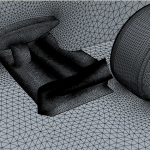 by Parv KhuranaThis blog explains how to set up industrial simulations using the Incompressible Navier-Stokes (IncNS) Solver in Nektar++. The geometry here is the Imperial Front Wing (IFW), an unraced front-wing configuration of the McLaren MP4-17D race car. Combined with a rolling wheel, it is a representative model for modern open-wheel motorsports, especially Formula 1 front-wing designs.
by Parv KhuranaThis blog explains how to set up industrial simulations using the Incompressible Navier-Stokes (IncNS) Solver in Nektar++. The geometry here is the Imperial Front Wing (IFW), an unraced front-wing configuration of the McLaren MP4-17D race car. Combined with a rolling wheel, it is a representative model for modern open-wheel motorsports, especially Formula 1 front-wing designs. - Nektar++ on the Imperial College HPC cluster – HX1
 by Chris CantwellHX1 (or Hex) is the new High Performance Computing Cluster provided by the Research Computing Services at Imperial College London. This post describes how to set up Nektar++ on HX1.
by Chris CantwellHX1 (or Hex) is the new High Performance Computing Cluster provided by the Research Computing Services at Imperial College London. This post describes how to set up Nektar++ on HX1. - Radially heated Taylor-Couette flow in Nektar++
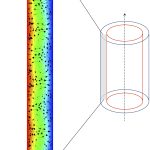 by Mohsen LahootiTaylor-Couette (TC) flow involves fluid motion between rotating concentric cylinders, one of the key problems in fluid dynamics. In this study, we aim to focus on the effects of ‘sinusoidal’ radial heating on the TC flow dynamics.
by Mohsen LahootiTaylor-Couette (TC) flow involves fluid motion between rotating concentric cylinders, one of the key problems in fluid dynamics. In this study, we aim to focus on the effects of ‘sinusoidal’ radial heating on the TC flow dynamics. - Computational modelling of underwater acoustic propagation with Nektar++
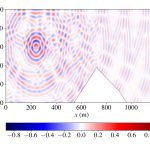 by Mohsen LahootiUnderwater radiated noise from shipping activities and offshore wind turbine construction/operation acts as a stressor for marine mammals. Using Nektar’s high-order spectral element method the Acoustic Perturbation Equations were numerically solved to explore the complex physics of acoustic scattering and interference of acoustic waves.
by Mohsen LahootiUnderwater radiated noise from shipping activities and offshore wind turbine construction/operation acts as a stressor for marine mammals. Using Nektar’s high-order spectral element method the Acoustic Perturbation Equations were numerically solved to explore the complex physics of acoustic scattering and interference of acoustic waves. - Nektar++ 5.5.0 Released
 by Chris CantwellThe latest version of Nektar++, v5.5.0, was released on the 31st January 2024.
by Chris CantwellThe latest version of Nektar++, v5.5.0, was released on the 31st January 2024. - NekMesh: An open-source high-order mesh generation framework
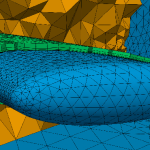 by Chris CantwellDOI: 10.2139/ssrn.4632754
by Chris CantwellDOI: 10.2139/ssrn.4632754
We present NekMesh: an open-source mesh generation package which is designed to enable the generation of valid, high-quality curvilinear meshes of complex, three-dimensional geometries for performing high-order simulations. - Three-dimensional transition and forcecharacteristics of low-Reynolds-number flowspast a plunging airfoil
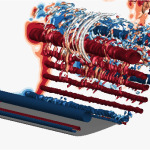 by Ankang GaoDOI: 10.1017/jfm.2023.735
by Ankang GaoDOI: 10.1017/jfm.2023.735
The three-dimensional (3-D) transition of the leading-edge vortex (LEV) and the force characteristics of the plunging airfoil are investigated in the chord-based Strouhal number Stc range of 0.10 to 1.0 by means of experimental measurements, numerical simulations and linear stability analysis in order to understand the spanwise instabilities and the effects on the force. - Aeroacoustic Analysis of a Closely Installed Chevron Nozzle Jet using the High-Order Discontinuous Galerkin Method
 by James EdgeleyDOI: 10.2514/6.2023-3831
by James EdgeleyDOI: 10.2514/6.2023-3831
Large Eddy Simulations (LES) in combination with the Ffowcs Williams – Hawkings method to study the influence of chevrons on the flow field as well as the noise produced by a closely installed M = 0.6 jet. - Nektar++ Workshop 2023
 by Chris CantwellThe 7th annual Nektar++ Workshop will bring together developers and users of all experiences to hear about new and future developments in the Nektar++ spectral/hp element framework and the exciting science and engineering being undertaken with the code.
by Chris CantwellThe 7th annual Nektar++ Workshop will bring together developers and users of all experiences to hear about new and future developments in the Nektar++ spectral/hp element framework and the exciting science and engineering being undertaken with the code. - Large Eddy Simulation of an Inverted Multi-element Wing in Ground Effect
 by James EdgeleyDOI: 10.1007/s10494-023-00404-7
by James EdgeleyDOI: 10.1007/s10494-023-00404-7
A computational study of a multi-element aerofoil containing unsteady analysis of force and surface pressure data. The mainplane and flap laminar separation are studied and the cross-spectral phase is presented for the lower frequency modes. - Large Eddy Simulations of Isolated and Installed Jet Noise using the High-Order Discontinuous Galerkin Method
 by James EdgeleyDOI: 10.2514/6.2023-1546
by James EdgeleyDOI: 10.2514/6.2023-1546
A recently developed computational framework for jet noise is used to compute the noise generated by an isolated and installed jet. - LES/DNS fluid-structure interaction simulation of non-linear slender structures in Nektar++ framework
 by James EdgeleyDevelopment of two fluid-structure interaction (FSI) solvers for simulations of highly deformable nonlinear slender structures.
by James EdgeleyDevelopment of two fluid-structure interaction (FSI) solvers for simulations of highly deformable nonlinear slender structures. - Nektar++ Workshop 2022
 by Chris CantwellThe 6th annual Nektar++ Workshop will bring together developers and users of all experiences to hear about new and future developments in the Nektar++ spectral/hp element framework and the exciting science and engineering being undertaken with the code. The three days will include a comprehensive programme of talks and a poster session. The workshop will be run… Read more: Nektar++ Workshop 2022
by Chris CantwellThe 6th annual Nektar++ Workshop will bring together developers and users of all experiences to hear about new and future developments in the Nektar++ spectral/hp element framework and the exciting science and engineering being undertaken with the code. The three days will include a comprehensive programme of talks and a poster session. The workshop will be run… Read more: Nektar++ Workshop 2022 - Computer Physics Communications Seminar
 by Chris CantwellThe Nektar++ team recently gave an online seminar as part of the Computer Physics Communications seminar series.
by Chris CantwellThe Nektar++ team recently gave an online seminar as part of the Computer Physics Communications seminar series. - Nektar++ on the JUWELS supercomputer
 by Daniel LindbladIn this post we will explain how to compile and run Nektar++ on the JUWELS supercomputer. The JUWELS supercomputer consists of two modules, the cluster module and the booster module. The booster module contains Nvidia GPU accelerators, and is not going to be covered in this post. Instead, we will focus on the booster module,… Read more: Nektar++ on the JUWELS supercomputer
by Daniel LindbladIn this post we will explain how to compile and run Nektar++ on the JUWELS supercomputer. The JUWELS supercomputer consists of two modules, the cluster module and the booster module. The booster module contains Nvidia GPU accelerators, and is not going to be covered in this post. Instead, we will focus on the booster module,… Read more: Nektar++ on the JUWELS supercomputer - Meshing complex geometry using SOLIDWORKS and STAR-CCM+
 by Ankang GaoFor complex geometries, we can use Solidworks to build the CAD model and use star-ccm+ for mesh generation. This blog gives a step-by-step instruction on the mesh generation of a round-tip wing.
by Ankang GaoFor complex geometries, we can use Solidworks to build the CAD model and use star-ccm+ for mesh generation. This blog gives a step-by-step instruction on the mesh generation of a round-tip wing. - Leading-edge vortex dynamics on plunging airfoils and wings
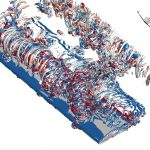 by Ankang GaoDOI: 10.1017/jfm.2022.224
by Ankang GaoDOI: 10.1017/jfm.2022.224
The vortex dynamics of leading-edge vortices on plunging high-aspect-ratio (AR = 10) wings and airfoils were investigated by means of volumetric velocity measurements, numerical simulations and stability analysis to understand the deformation of the leading-edge vortex filament and spanwise instabilities. - Mesh conversion from Ansys ICEM CFD to Nektar++
 by Ankang GaoAnsys ICEM CFD is a popular mesh generation software. In this blog, we show how to convert the mesh generated by ICEM to Nektar++ format.
by Ankang GaoAnsys ICEM CFD is a popular mesh generation software. In this blog, we show how to convert the mesh generated by ICEM to Nektar++ format. - Mesh conversion from Pointwise/Gridgen to Nektar++
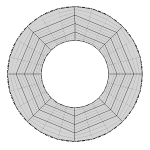 by gl19In applications Pointwise (or the predecessor Gridgen) is a popular mesh generation software. In this post we go through the procedures to convert the linear mesh generated by Pointwise/Gridgen to arbitrary high order mesh for the solvers in Nektar++.
by gl19In applications Pointwise (or the predecessor Gridgen) is a popular mesh generation software. In this post we go through the procedures to convert the linear mesh generated by Pointwise/Gridgen to arbitrary high order mesh for the solvers in Nektar++. - Post-processing flow fields in the finite-difference grid
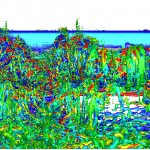 by Ankang GaoThe visualisation of the flow fields output by Nektar++ may not look smooth if the resolution is not enough. A feasible solution is interpolating the spectral element field to a finite difference grid and then doing the post-processing using a Gaussian filter.
by Ankang GaoThe visualisation of the flow fields output by Nektar++ may not look smooth if the resolution is not enough. A feasible solution is interpolating the spectral element field to a finite difference grid and then doing the post-processing using a Gaussian filter. - Post-processing on ARCHER2
 by Mohsen LahootiIn this post, you will learn how to run an interactive job on ARCHER2 for postprocessing using Paraview.
by Mohsen LahootiIn this post, you will learn how to run an interactive job on ARCHER2 for postprocessing using Paraview. - Flow past a circular cylinder: numerical convergence and computational efficiency
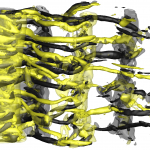 by Administratorby Hongyi Jiang (University of Western Australia)
by Administratorby Hongyi Jiang (University of Western Australia)
DOI: 10.1063/5.0041168
Using Nektar++, we report a systematic numerical convergence study for the case of flow past a circular cylinder at Re = 3900. - Nektar++ Workshop 2021
 by Chris CantwellThe 5th annual Nektar++ Workshop will bring together developers and users of all experiences to hear about new and future developments in Nektar++ and the exciting science and engineering being undertaken with the code.
by Chris CantwellThe 5th annual Nektar++ Workshop will bring together developers and users of all experiences to hear about new and future developments in Nektar++ and the exciting science and engineering being undertaken with the code. - Nektar++ outline videos and presentations
 by Spencer SherwinAt our recent Nektar++ tutorial we produced a number of videos supporting the background of the framework. We include them here for general reference and also make the presentations available in Keynote and Powerpoint formats.
by Spencer SherwinAt our recent Nektar++ tutorial we produced a number of videos supporting the background of the framework. We include them here for general reference and also make the presentations available in Keynote and Powerpoint formats. - Industry-relevant implicit LES via spectral/hp element methods
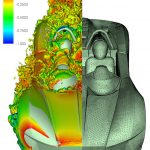 by Gianmarco MengaldoWe present the successful deployment of high-fidelity Large-Eddy Simulation (LES) technologies based on spectral/hp element methods (SEM) to an industry-relevant configuration. The simulation is carried out on a real automotive car, namely the Elemental Rp1 model.
by Gianmarco MengaldoWe present the successful deployment of high-fidelity Large-Eddy Simulation (LES) technologies based on spectral/hp element methods (SEM) to an industry-relevant configuration. The simulation is carried out on a real automotive car, namely the Elemental Rp1 model. - Nektar++ on ARCHER2
 by Mohsen LahootiThe ARCHER2 national supercomputer is a world class advanced computing resource and is the successor to ARCHER. This guide is intended to provide basic instructions for compiling the Nektar++ stable release or master branch on the ARCHER2 system.
by Mohsen LahootiThe ARCHER2 national supercomputer is a world class advanced computing resource and is the successor to ARCHER. This guide is intended to provide basic instructions for compiling the Nektar++ stable release or master branch on the ARCHER2 system. - The wake passing effect in LPTs with Nektar++
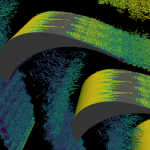 by Andrea CassinelliThis blog highlights some research efforts aimed at simulating the wake passing effect in a low pressure turbine cascade, analysed over the entire operating range. The incoming disturbances modify the physical transition mechanism on the suction surface, giving rise to complex flow phenomena.
by Andrea CassinelliThis blog highlights some research efforts aimed at simulating the wake passing effect in a low pressure turbine cascade, analysed over the entire operating range. The incoming disturbances modify the physical transition mechanism on the suction surface, giving rise to complex flow phenomena. - Speed Comparison among Nektar++ Solvers
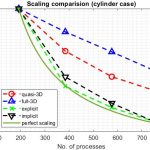 by Ganwei WangThere are various flow solvers built in Nektar++ that exploit different numerical approaches. This this article provides some results on the comparison of four different solver setups that are commonly used, based on two standard benchmark cases.
by Ganwei WangThere are various flow solvers built in Nektar++ that exploit different numerical approaches. This this article provides some results on the comparison of four different solver setups that are commonly used, based on two standard benchmark cases. - Mixing at low Reynolds with NEKTAR++
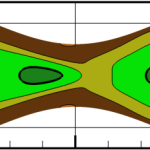 by sgepnerCan hydrodynamic instability be used for mixing? And at the same time can conduits be shaped such that hydraulic losses are reduced? We think that it is Yes to both.
by sgepnerCan hydrodynamic instability be used for mixing? And at the same time can conduits be shaped such that hydraulic losses are reduced? We think that it is Yes to both. - Building and running Nektar++ in Parallel on Windows 10 with MPI
 by Jeremy CohenThis post details how to undertake an MPI build of Nektar++ on Windows 10. Support has recently been added for building with MPI on Windows and a detailed explanation is provided of how to carry out the build and test process and run a sample simulation.
by Jeremy CohenThis post details how to undertake an MPI build of Nektar++ on Windows 10. Support has recently been added for building with MPI on Windows and a detailed explanation is provided of how to carry out the build and test process and run a sample simulation. - Formula One front wing simulation with Nektar++
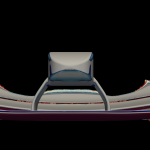 by Filipe Fabian BuscarioloDevelopment of a new standard test case for automotive applications.
by Filipe Fabian BuscarioloDevelopment of a new standard test case for automotive applications. - Spectral/hp element methods for turbomachinery
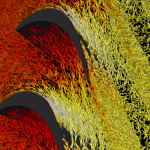 by Andrea CassinelliA T106A low pressure turbine vane was investigated at moderate regime (Re = 88450), exploring the convergence properties of the main flow statistics with the aim of developing a set of best practices to achieve DNS resolution.
by Andrea CassinelliA T106A low pressure turbine vane was investigated at moderate regime (Re = 88450), exploring the convergence properties of the main flow statistics with the aim of developing a set of best practices to achieve DNS resolution. - Nektar++ Workshop 2019
 by Dave MoxeyThe 4th annual Nektar++ workshop will be held this year between June 10-12th 2019 at the University of Exeter, UK. For full details, see the main Nektar++ workshop page.
by Dave MoxeyThe 4th annual Nektar++ workshop will be held this year between June 10-12th 2019 at the University of Exeter, UK. For full details, see the main Nektar++ workshop page. - Nektar++ on Clowder (SBC ARM “cluster”)
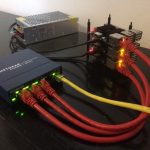 by gcastiglClowder The Clowder cluster is currently composed by 3 Odroid-C2 single board computers (SBC), a 5 port Gigabit Ethernet switch (Netgear GS105) and a 5V 12A power supply (see Figure 1). The Odroid-C2 is a SBC equipped with a Amlogic ARM Cortex-A53(ARMv8) 1.5Ghz quad core CPU, 2 Gbyte DDR3 SDRAM, and Gigabit Ethernet. The Odroid-C2… Read more: Nektar++ on Clowder (SBC ARM “cluster”)
by gcastiglClowder The Clowder cluster is currently composed by 3 Odroid-C2 single board computers (SBC), a 5 port Gigabit Ethernet switch (Netgear GS105) and a 5V 12A power supply (see Figure 1). The Odroid-C2 is a SBC equipped with a Amlogic ARM Cortex-A53(ARMv8) 1.5Ghz quad core CPU, 2 Gbyte DDR3 SDRAM, and Gigabit Ethernet. The Odroid-C2… Read more: Nektar++ on Clowder (SBC ARM “cluster”) - Building Nektar++ on platforms without outgoing Internet accessby Jeremy CohenThis blog post explains how to manually work around this issue by placing the correct third party dependencies in the correct location on the target system such that Nektar++ is able to discover and use them during the build process without needing to attempt to download the files.
- Nektar++ and hydrodynamic stability in undulated channels
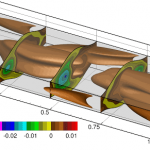 by sgepnerNektar++ has been used to study various forms of hydrodynamic instabilities arising is a flow through a channel with corrugated walls. Stability analysis has been performed using direct numerical simulation and tracking growth, or attenuation of the unstable modes.
by sgepnerNektar++ has been used to study various forms of hydrodynamic instabilities arising is a flow through a channel with corrugated walls. Stability analysis has been performed using direct numerical simulation and tracking growth, or attenuation of the unstable modes. - Dispersion and Diffusion analysis of discontinuous spectral element methods for LES
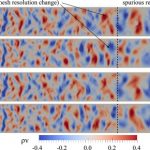 by Gianmarco MengaldoNektar++ has been recently used to verify the dispersion/diffusion estimates of discontinuous spectral element methods for non-periodic flow problems. This work a key implications on the effective construction of LES tools for industrial problems.
by Gianmarco MengaldoNektar++ has been recently used to verify the dispersion/diffusion estimates of discontinuous spectral element methods for non-periodic flow problems. This work a key implications on the effective construction of LES tools for industrial problems. - Nektar++ on the UCL Thomas cluster
 by Filipe Fabian BuscarioloBrief description of and Nektar++ installation instructions for Thomas, the UK National Tier 2 High Performance Computing Hub in Materials and Molecular Modelling.
by Filipe Fabian BuscarioloBrief description of and Nektar++ installation instructions for Thomas, the UK National Tier 2 High Performance Computing Hub in Materials and Molecular Modelling. - Nektar++ strong scaling performance on Mira
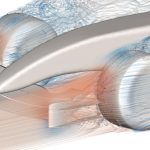 by Dave MoxeyWe have recently performed some tests of the Nektar++ incompressible Navier-Stokes solver on a Formula 1 car geometry. The tests were run on Mira up to 131k cores and show excellent scaling of of the code for massively parallel simulations.
by Dave MoxeyWe have recently performed some tests of the Nektar++ incompressible Navier-Stokes solver on a Formula 1 car geometry. The tests were run on Mira up to 131k cores and show excellent scaling of of the code for massively parallel simulations. - Nektar++ workshop programme
 by Spencer SherwinA Programme for the Nektar++ workshop is now available: Nektar++ Workshop 2017
by Spencer SherwinA Programme for the Nektar++ workshop is now available: Nektar++ Workshop 2017 - Direct numerical simulations of flow around wavy wings
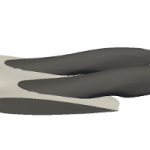 by dsersonNektar++ has been used to investigate the incompressible flow around wings with spanwise waviness, using direct numerical simulations at different Reynolds numbers. The waviness was imposed by a coordinate transformation, using a novel technique presented in our JCP paper (1). This global mapping allowed us to consider a 2.5D problem, leading to significant advantages in terms… Read more: Direct numerical simulations of flow around wavy wings
by dsersonNektar++ has been used to investigate the incompressible flow around wings with spanwise waviness, using direct numerical simulations at different Reynolds numbers. The waviness was imposed by a coordinate transformation, using a novel technique presented in our JCP paper (1). This global mapping allowed us to consider a 2.5D problem, leading to significant advantages in terms… Read more: Direct numerical simulations of flow around wavy wings - Nektar++ Workshop 2017
 by Chris CantwellThe Nektar++ Workshop 2017 will be held at Imperial College on 14th-15th June 2017. The 3rd annual Nektar++ Workshop will bring together developers and users of all experiences to hear about new and future developments in Nektar++ and the exciting science and engineering being undertaken with the code.
by Chris CantwellThe Nektar++ Workshop 2017 will be held at Imperial College on 14th-15th June 2017. The 3rd annual Nektar++ Workshop will bring together developers and users of all experiences to hear about new and future developments in Nektar++ and the exciting science and engineering being undertaken with the code. - Nektar++ v4.4.0 released
 by Chris CantwellThe latest version of Nektar++, v4.4.0, was released on the 9th March 2017. It can be downloaded from the downloads page.
by Chris CantwellThe latest version of Nektar++, v4.4.0, was released on the 9th March 2017. It can be downloaded from the downloads page. - Understanding the fluid mechanics behind transverse wall shear stress
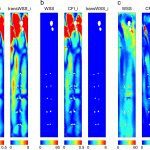 by AdministratorDOI: 10.1016/j.jbiomech.2016.11.035
by AdministratorDOI: 10.1016/j.jbiomech.2016.11.035
Here we use numerical methods to investigate the nature of the arterial flows captured by transWSS and the sensitivity of transWSS to inflow waveform and aortic geometry. - Contributing to Nektar++
 by AdministratorWe encourage people who extend the code to help with their research to contribute those changes back into the main codebase for the benefit of other researchers. We have a number of tools and processes to help this including a code repository, a testing framework, code review and a continuous integration system.
by AdministratorWe encourage people who extend the code to help with their research to contribute those changes back into the main codebase for the benefit of other researchers. We have a number of tools and processes to help this including a code repository, a testing framework, code review and a continuous integration system. - Installing Nektar++ on OS X through MacPorts or Homebrewby Dave MoxeyThis post briefly summarises how to install Nektar++ using either the MacPorts or Homebrew package managers. Both of these install a version of Nektar++ that includes MPI for parallel execution, ARPACK for stability analysis, FFTW for homogeneous expansions, PETSc support and a full set of solvers. They can also both be used to install development versions of Nektar++.
- Direct numerical simulation of laminar-turbulent transition
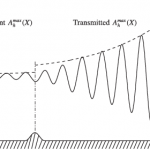 by Hui XuThe process of laminar-turbulent transition consists of three stages: receptivity, linear eigenmode growth and nonlinear breakdown to turbulence. Recently, the interaction between Tollmien–Schlichting waves and base flow distorted by 3D localised roughness elements has also been studied.
by Hui XuThe process of laminar-turbulent transition consists of three stages: receptivity, linear eigenmode growth and nonlinear breakdown to turbulence. Recently, the interaction between Tollmien–Schlichting waves and base flow distorted by 3D localised roughness elements has also been studied. - Nektar++ on ECMWF Cray XC30
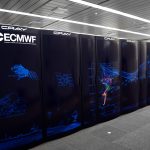 by Gianmarco MengaldoThe ECMWF HPC facilities are composed by two identical Cray XC30 systems that support both operational forecast requirements of the centre and research.
by Gianmarco MengaldoThe ECMWF HPC facilities are composed by two identical Cray XC30 systems that support both operational forecast requirements of the centre and research. - Nektar++ on Copper (Cray XE6)
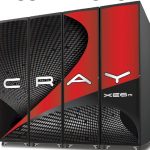 by Gianmarco MengaldoCopper is a Cray XE6 system and supports research programs of the United the States Department of Defense (DoD). The system is provided for computationally based science and engineering and is intended for high performance computing, large-scale storage, and utility computing.
by Gianmarco MengaldoCopper is a Cray XE6 system and supports research programs of the United the States Department of Defense (DoD). The system is provided for computationally based science and engineering and is intended for high performance computing, large-scale storage, and utility computing. - PRISM Workshop on Embracing Accelerators
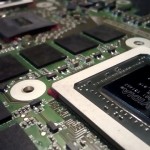 by Chris Cantwell
by Chris CantwellMembers of PRISM community are delighted to invite you to Imperial College on Monday 18th April for an event that explores the use of accelerators with finite element methods. More information is available here.
- Eigensolution analysis of spectral/hp continuous Galerkin approximations to advection–diffusion problems: insights into spectral vanishing viscosity
 by Rodrigo MouraDOI: 10.1016/j.jcp.2015.12.009
by Rodrigo MouraDOI: 10.1016/j.jcp.2015.12.009
This study addresses linear dispersion–diffusion analysis for the spectral/hp continuous Galerkin (CG) formulation in one dimension. - Nektar++ on the Mira Cluster
 by Martin VymazalMira is a Blue Gene/Q supercomputer ran by the Argonne national laboratory. As of 2016, it is ranked as the fifth-fastest supercomputer in the world. If you are interested in using Nektar++ on Mira, please read on. Users of Mira often have access to Cetus, a smaller cluster with the same architecture as Mira. The… Read more: Nektar++ on the Mira Cluster
by Martin VymazalMira is a Blue Gene/Q supercomputer ran by the Argonne national laboratory. As of 2016, it is ranked as the fifth-fastest supercomputer in the world. If you are interested in using Nektar++ on Mira, please read on. Users of Mira often have access to Cetus, a smaller cluster with the same architecture as Mira. The… Read more: Nektar++ on the Mira Cluster - Formula 1
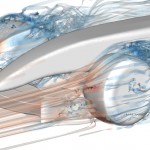 by Jean-Eloi LombardNektar++ has been used to investigate the flow dynamics and vortex generation behind the front section of a Formula 1 racing car. The above image shows the flow trajectory, coloured by pressure, at a Reynolds number of 220,000, based on the chord of the main-plane of the front-wing. The simulation has 13 million degrees of… Read more: Formula 1
by Jean-Eloi LombardNektar++ has been used to investigate the flow dynamics and vortex generation behind the front section of a Formula 1 racing car. The above image shows the flow trajectory, coloured by pressure, at a Reynolds number of 220,000, based on the chord of the main-plane of the front-wing. The simulation has 13 million degrees of… Read more: Formula 1 - Profiling using Solaris Studio
 by Chris CantwellOracle Solaris Studio is a free proprietary development suite that includes compilers and analysis tools. It is available from here for free download upon a quite non-restrictive license agreement and it can be used locally on Linux machines with Java installed. On the internal Nektar++ compute nodes it is made available by running This pages describes how to use… Read more: Profiling using Solaris Studio
by Chris CantwellOracle Solaris Studio is a free proprietary development suite that includes compilers and analysis tools. It is available from here for free download upon a quite non-restrictive license agreement and it can be used locally on Linux machines with Java installed. On the internal Nektar++ compute nodes it is made available by running This pages describes how to use… Read more: Profiling using Solaris Studio - Compressible flow
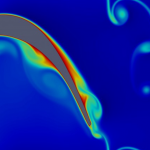 by Daniele de GraziaNektar++ includes a solver for simulating the dynamics of compressible inviscid/viscous flow on unstructured two-dimensional and three-dimensional meshes. Specifically, the solver solves two system of equations: Euler equations; Navier-Stokes equations. The systems are provided with a comprehensive set of boundary conditions (1) for specifying inflow/outflow variables as well as wall conditions. In both the systems appropriate techniques for… Read more: Compressible flow
by Daniele de GraziaNektar++ includes a solver for simulating the dynamics of compressible inviscid/viscous flow on unstructured two-dimensional and three-dimensional meshes. Specifically, the solver solves two system of equations: Euler equations; Navier-Stokes equations. The systems are provided with a comprehensive set of boundary conditions (1) for specifying inflow/outflow variables as well as wall conditions. In both the systems appropriate techniques for… Read more: Compressible flow - Nektar++ on the Imperial College HPC cluster
 by Chris CantwellImperial College’s HPC system contains computing resources suitable for a broad range of jobs. Node sizes and interconnects therefore vary. This cluster is useful for serial runs, small and large parallel runs, parameter sweep studies, etc. There are also some dedicated private queues which some users may have access.
by Chris CantwellImperial College’s HPC system contains computing resources suitable for a broad range of jobs. Node sizes and interconnects therefore vary. This cluster is useful for serial runs, small and large parallel runs, parameter sweep studies, etc. There are also some dedicated private queues which some users may have access. - On the Connections Between Discontinuous Galerkin and Flux Reconstruction Schemes: Extension to Curvilinear Meshes
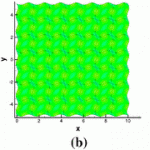 by Gianmarco MengaldoDOI: 10.1007/s10915-015-0119-z/fulltext.html
by Gianmarco MengaldoDOI: 10.1007/s10915-015-0119-z/fulltext.html
This paper investigates the connections between many popular variants of the well-established discontinuous Galerkin method and the recently developed high-order flux reconstruction approach on irregular tensor-product grids. - Dealiasing techniques for high-order spectral element methods on regular and irregular grids
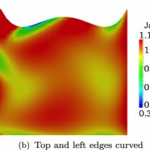 by Gianmarco MengaldoDOI: 10.1016/j.jcp.2015.06.032
by Gianmarco MengaldoDOI: 10.1016/j.jcp.2015.06.032
In this work we detail two dealiasing strategies based on the concept of consistent integration. The first uses a localised approach, which is useful when the nonlinearities only arise in parts of the problem. The second is based on the more traditional approach of using a higher quadrature. - Linear dispersion-diusion analysis and its application to under-resolved turbulence simulations using discontinuous Galerkin spectral/hp methods
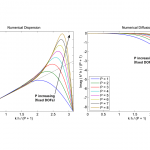 by Rodrigo MouraDOI: 10.1016/j.jcp.2015.06.020
by Rodrigo MouraDOI: 10.1016/j.jcp.2015.06.020
We investigate the potential of linear dispersion–diffusion analysis in providing direct guidelines for turbulence simulations through the under-resolved DNS (sometimes called implicit LES) approach via spectral/hp methods. The discontinuous Galerkin (DG) formulation is assessed in particular as a representative of these methods. - Triple-deck and direct numerical simulation analyses of high-speed subsonic flows past a roughness element
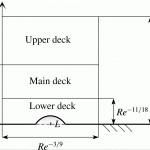 by Gianmarco MengaldoDOI: 10.1017/jfm.2015.281
by Gianmarco MengaldoDOI: 10.1017/jfm.2015.281
This paper is concerned with the boundary-layer separation in subsonic and transonic flows caused by a two-dimensional isolated wall roughness. The process of the separation is analysed by means of two approaches: the direct numerical simulation (DNS) of the flow using the Navier–Stokes equations, and the numerical solution of the triple-deck equations. - Nektar++: An open-source spectral/hp element framework
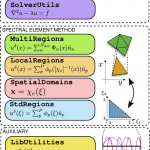 by Chris CantwellDOI: 10.1016/j.cpc.2015.02.008
by Chris CantwellDOI: 10.1016/j.cpc.2015.02.008
Nektar++ is an open-source software framework designed to support the development of high-performance scalable solvers for partial differential equations using the spectral/hp element method. - Nektar++ on ARCHER
 by Chris CantwellThe ARCHER national supercomputer is intended for very large-scale computations and is the successor to HECToR. These instructions are preliminary in nature and an up-to-date version of the master branch is required as support for the compilation environment has only been added recently.
by Chris CantwellThe ARCHER national supercomputer is intended for very large-scale computations and is the successor to HECToR. These instructions are preliminary in nature and an up-to-date version of the master branch is required as support for the compilation environment has only been added recently. - A Guide to the Implementation of Boundary Conditions in Compact High-Order Methods for Compressible Aerodynamics
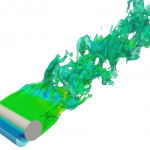 by Gianmarco MengaldoDOI: 10.2514/6.2014-2923
by Gianmarco MengaldoDOI: 10.2514/6.2014-2923
The nature of boundary conditions, and how they are implemented, can have a significant impact on the stability and accuracy of a Computational Fluid Dynamics (CFD) solver. The objective of this paper is to assess how different boundary conditions impact the performance of compact discontinuous high-order spectral element methods (such as the discontinuous Galerkin method and the Flux Reconstruction approach), when these schemes are used to solve the Euler and compressible Navier-Stokes equations on unstructured grids. - Nektar++ on IDRIS (France)
 by Chris CantwellThe following is the script used to configure Nektar++ 3.4 on IDRIS (large HPC cluster in France). This script must be lauched from a directory containing nektar++-3.4.0.tar.gz and ThirdParty-3.4.0.tar.gz. ThirdParty In order to build ThirdParty-3.4.0.tar.gz, follow these steps from an internet-enabled computer: Nektar++ Then do the following:
by Chris CantwellThe following is the script used to configure Nektar++ 3.4 on IDRIS (large HPC cluster in France). This script must be lauched from a directory containing nektar++-3.4.0.tar.gz and ThirdParty-3.4.0.tar.gz. ThirdParty In order to build ThirdParty-3.4.0.tar.gz, follow these steps from an internet-enabled computer: Nektar++ Then do the following: